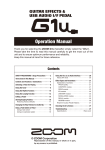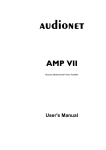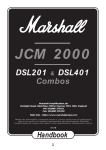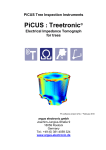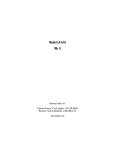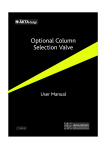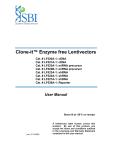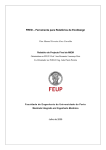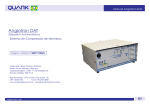Download CAVAT Full Method: User's Guide
Transcript
CAVAT (Capital Asset Value for Amenity Trees) Full Method: User’s Guide Christopher Neilan ©Christopher Neilan September 2010 1 Introduction CAVAT (Capital Asset Value for Amenity Trees) provides a basis for managing trees in the UK as public assets rather than liabilities. It is designed not only to be a strategic tool and aid to decision-making in relation to the tree stock as a whole, but also to be applicable to individual cases, where the value of a single tree needs to be expressed in monetary terms. It is intended particularly for councils and other Public Authorities and primarily for publicly owned trees. However, it may be used by other public bodies, including the Courts, private institutions and individuals. It complements other tools of arboricultural analysis, such as single tree hazard assessment systems. So far as possible it draws upon objective evidence and published data, but it also relies on expert arboricultural knowledge and in some cases assessments that are specific to CAVAT. It can therefore only be used by arboriculturists who have received relevant training, and who have the relevant skills and experience. It is established in UK law, in the Town and Country Planning Act 1990 Section 198, that trees have value as a public amenity and therefore local planning authorities are given a duty to protect trees in the public interest. The legislation itself does not specify how amenity is to be assessed, leaving it open for the value of trees to be expressed in the most appropriate way for the intended purpose, and not necessarily in monetary terms. Because CAVAT is specifically designed as an asset management tool for trees that are publicly owned, or of public importance, it does express value in monetary terms, and in a way that is directly related to the quantum of public benefits that each particular tree provides. Applied to the tree stock as a whole it enables it to be managed as if it were a financial asset of the community. Applied to single trees it gives a value that is meaningful in itself but allows a comparison to be made with the value of other public trees. CAVAT works by calculating a unit value for each square centimetre of tree stem, by extrapolation from the average cost of a range of newly planted trees. In the Full Method this basic value is adjusted to reflect the degree of benefit that the tree provides to the local population. The adjustment is designed to allow the final value to reflect realistically the contribution of the tree to public welfare through tangible and intangible benefits. (See Note 1). The Two Methods There are two versions of the CAVAT method. The Full Method, described in this Guide, is recommended for use in cases concerning individual trees or groups, when precision is required and sufficient time is available for a full assessment. The second, referred to as the Quick Method, is intended specifically as a strategic tool for management of the stock as a whole, as if it were a financial asset of the community. The data required is limited to the minimum necessary to express the value of the tree stock as a whole, to analyse it, and to provide information to assist with management decisions. The data may be collected in conjunction with regular surveys of the tree stock. In effect, it is designed to enable the value of the public tree stock to be expressed as an index. The index would rise or fall with changes in the quality and character of the stock over time. The tree manager would act as an asset manage, showing evidence to increase the overall value year by year, bearing in mind the particular nature and disposition of the stock, and the opportunities and resources available. The Guide to the Quick Method is published separately. General Instructions for the Full Method. ©Christopher Neilan September 2010 2 Although the method is designed to be robust, prospective users need to be aware of certain key principles and the need for training to ensure consistency and accuracy of results. Steps 1 and 2 in both methods rely on measurement, government data, and the conversion formula, updated annually to take account of inflation, but also the assessment of accessibility which is specific to CAVAT. Step 3, Functionality, relies on expert assessment, also specific to CAVAT. For example, when the health of the tree is assessed the key judgement is not whether it has flaws to the arboricultural expert, but to what extent those flaws detract from its current performance as a public amenity. Where there is no loss of performance no penalty is imposed. Any potential shortening of life expectancy, say as a result of structural weakness, would be considered separately at Step 5. Steps 4 and 5 apply only to the Full Method. At Step 4 the adjustments for amenity rely on observation, but also plant knowledge; at Step 5 the assessor requires a good understanding of tree health, and the ability to estimate reliably the safe life expectancy of the tree. Assessors must also be aware that CAVAT does not discount the value of trees generally to account for indirect problems that they may cause, such as the potential to cause structural damage, nor additional costs of management to resolve any such problems. This is because it is designed to give a cost/benefit analysis, and to allow for these costs within the method would lead to a form of double accounting. However, the Full Method does discount value as part of Step 4, Adjusted Value, when it is found that there is an intrinsic problem, that is to say direct harm is being caused by the tree without it being resolved by management. The Full Method The Full Method is used in situations when a more detailed and precise assessment of the value of trees as individuals is required. For example, it would be used when reviewing the management options available for an individual tree or a group or avenue. In relation to cases involving subsidence, according to the JMP (Joint Mitigation Protocol) the levels of evidence to be submitted in cases involving public trees will be set by reference to a full CAVAT valuation to be undertaken by the Local Authority. The Full Method involves a site inspection, and may in occasional cases involve further investigation, including internal decay detection or a climbing inspection. A full record of the inspection must be retained with appropriate evidence, including photographs. The Variables The Full Method involves five steps, and sets of key variables: 1. 2. 3. 4. 5. Basic value/unit value x size; CTI value/location, in terms of population and use, and accessibility; Functional value/functional status; Adjusted value/amenity factors, both positive and negative; and Full value/safe life expectancy. Step 1: Basic Value. ©Christopher Neilan September 2010 3 The basic value is calculated using trunk area as key measure of size. The trunk area is calculated in the standard way by using the measured trunk diameter or circumference, and converted to give the radius. The current national unit value factor is selected to allow the basic value to be calculated, using the equation: V = n x radius2 x unit value factor. (See notes 2 and 3). A spreadsheet – the CAVAT calculation – Full Method available separately, has been produced to make the necessary calculations for the Full Method. When using it the basic value is automatically calculated, using the diameter and the UVF. Step 2: CTI Value. There are two operations in Step 2. Firstly, the basic value is adjusted to take account of the population density using the Community Tree Index (CTI) factor (see note 4). Then the modified basic value is discounted by up to 60%, according to how accessible the tree is in the particular location. The CTI index factor is a measure of the relative population density potentially able to benefit from the trees, derived from Office of National Statistics (ONS) information. The values of the 7 CTI bands are shown in Table A. They vary from 100%, for the majority of the country, up to a maximum of 250% according to the published population density. The results as applied nationally to England can be found in the separate National Community Tree Index Table. (Note: The CTI factor supersedes the previous value band approach, based on differential planting costs, which no longer applies). Operation 1. The CTI index gives the basic adjustment for the Local Authority. The effective CTI value factor is that given in the final column of the table. In some instances, however, the area may not be typical of the Local Authority’s overall area. In that case the ward figure, also available form the ONS website, may be used, with the CTI index factor values as shown in Table A. Operation 2. The second operation is to consider the relative accessibility to the public of the tree in its general locality. The tree may retain 100% of its value, or be discounted by up to 60%. Taken together, these 2 operations give the CTI value. Step 3: Functional Value. The CTI value is then reduced according to the surveyor’s expert assessment of the tree’s functionality, i.e. how well it is performing biologically, as against what would be expected of a well-grown and healthy tree of the same species and girth in that location. The surveyor must consider crown size and crown condition (see Note 5). Only one combined adjustment of the basic value is required, giving overall functional value. Precision is required in the assessment, either maintaining the value at 100% or reducing it proportionately in increments of 10%. ©Christopher Neilan September 2010 4 Step 4: Adjusted Value. The functional value is then adjusted to take into account the surveyor’s assessment of any special amenity factors and also the tree’s appropriateness to the location. One combined adjustment is made; up to +/- 40% is possible. (See Note 6). Step 5: Full Value. Finally, the value is adjusted for safe life expectancy (SLE), assessed on the principles of SULE. (See Note 7). Trees with a safe life expectancy greater than 80 years retain 100% of their adjusted value; those with a life expectancy of less than 5 years lose 90%. The SLE adjustment bands are shown in Table E. No reduction is made for a condition, e.g. structural weakness, where life expectancy is not shortened and the tree is judged to be safe. However, if management, e.g. crown reduction is required, the functional status is adjusted accordingly under Step 3, Functional Value. A tree that cannot be safely retained has a SLE score of 0, and thus a value of £0. Notes Note 1: CAVAT, Lifetime Benefit and the Trunk Formula Method CAVAT has been designed primarily as an asset management tool. However, the full version is expressly designed for cases where the value of an individual tree needs to be expressed. The premise of CAVAT is that the widely accepted approach of depreciated replacement cost is used as the basis for a calculation of value since it is suitably robust, practicable and useful for these purposes. The basis of the method is to calculate the value of a tree by extrapolation from the cost of a newly planted standard tree, using the ratio between their respective trunk areas as the critical measurement. This approach is also used in the Council of Tree and Landscape Appraisers (CTLA) “trunk formula method”, an appraisal method widely used in the U.S.A. However the CAVAT methods are designed to give the value of trees as public assets in the UK in comparison to the CTLA method whose stated aim is to express the private value of the tree to its owner. CAVAT allows for the contribution of the factors of location, relative contribution to amenity social value and appropriateness, and an assessment of functionality and life expectancy. Essentially, the planting cost basis is then modified by a consideration of the impact of those factors that contribute to the quantum of benefits that the public may expect to receive from it. The factors which are essentially related to “wear and tear” on the tree, including a shortened life expectancy, are dealt with in terms of depreciation. On the other hand factors based on variation from an arithmetic mean, (for example the particular benefits that flow from the characteristics of the species in question) allow for a either a potential increase or decrease in value. Its results are broadly comparable with what research suggests both in the U.S.A. and the U.K. is a realistic estimate of the tangible lifetime benefits of trees to the community. The tangible benefits approach is reflected both in use of official population statistics to generate ©Christopher Neilan September 2010 5 the CTI index rating in CAVAT and the nature of the adjustment for functionality, and also in the scale of the adjustments for accessibility and amenity factors. Note 2: Basic Value. The relevant measurement to calculate the value for an individual tree in the Full Method is the area of trunk at breast height, using the standard CTLA Trunk Formula Methodology, from which the basic value is calculated, using equation A = ⊓ r2. The procedure, therefore, is first to measure the trunk radius in centimetres, (generally by converting the circumference to a radius by a “rounded-down” tape, or using the formula r = c÷2⊓). The radius is then squared, and multiplied by ⊓ (pi, approx. 3.142). This is subsequently converted into the basic value by multiplying by the current UVF (unit value factor). When using the spreadsheet the basic value is calculated automatically, using the diameter and the UVF. Note 3: The Unit Value Factor. (UVF) The UVF represents the full cost of a newly planted tree in a given area, divided by its trunk area. It has two components; the nursery gate price, expressed in terms of the cost of each square centimetre of stem, (or unit area cost) and the planting cost (transport, planting, materials, immediate care and management costs, but not after-care). The calculation of the unit area cost is from the average cost of a basket of species rather than for each individual species, in order to eliminate differences based only on production factors or variations in demand. The initial specification used in this calculation was 12-14 cm. standard containerised trees, however prior research has subsequently demonstrated that size, as opposed to species or production methods, is not generally a critical factor in unit cost variation. The current UVF represents the average cost per square centimetre of stem area of the ten most commonly planted species, containerised, at trade prices, and from equivalent and competitively prices nurseries including immediate planting costs. The best estimate of the planting cost factor has been found to be 150%, based on consultation with tree officers and within the wider landscape industry. By applying the Community Tree Index factor, the national unit area value may then be modified to take account of the effects of location to the benefits received by the local population, (see note 4). The unit area cost is upgraded each year in line with inflation, (using RPI/X) from an original survey in 2004/5. Again, this is to minimise fluctuations in the UVF unrelated to the tree stock’s contribution to public amenity. The up to date figure is used in the current CAVAT calculations, available separately. Note 4: Community Tree Index. To generate the CTI index factor in the Full Method the adjustment is made in two stages; first according to the population density of the wider location, and secondly according to the tree’s relative accessibility in that location. Any special characteristics of the immediate location are accounted for in step 4, Adjusted Value. ©Christopher Neilan September 2010 6 Operation 1 The CTI index factor is a measure of the relative population density of the local authority, and thus the relative number of those potentially able to benefit from the local authority’s trees. The CTI values for each Local Authority in England are shown in the separate National Community Tree Index table. It may give more accurate results to calculate the stock value on a ward by ward basis, rather than by using the overall local authority value. This will depend upon an assessment of whether the local authority is relatively homogenous in character overall, or whether there are significant variations from ward to ward. Ward statistics are available from the Office for National Statistics, via the ONS website, https://www.ons.co.uk/Default.asp. Operation 2 Having applied the factor for the general character of the area, the assessor then judges the relative accessibility of the tree within that area, and whether it is fully available to contribute to the public good. The potential CTI value after operation 1 may either be retained, by a score of 100%, or further reduced to a factor of 80%, 60% or 40% of its original value. The key considerations under operation 2 are: 1. 2. 3. Whether the tree is fully accessible to the public i.e. within a public highway, public park, or woodland. For these locations the accessibility score remains 100%. Wholly or partially accessible from public areas i.e. in a local authority owned location such as a school, local authority building or housing estate. For these locations the accessibility score is reduced to 80% of its original value. A less accessible publicly owned area i.e. a courtyard of a building, sheltered housing unit or individual back gardens of local authority owned properties. For these locations the accessibility score maybe reduced to 40% or 60% of its original value. A tree that is fully accessible and visible, in a prominent and well-used setting within the general area will score 100%; a tree not publicly accessible or visible will score 40% of its original value. A degree of judgement will be necessary to assess these scores. Note 5: Functionality. The basis of CAVAT is trunk area, but the crown area may often be reduced from what would be predicted for an average tree of the size by species characteristics, possibly exaggerated by grafting, as in many flowering cherries, or by pruning, or by natural events such as disease or branch failure. Alternatively, the crown may be fully present, but functioning poorly; in either case the assessor carefully estimates the adjustment to be made, so that the functional value represents as realistically as possible the actual capacity of the tree to provide public amenity. Only 1 adjustment is made for both crown size and condition. The two considerations are: 1. Crown Size. ©Christopher Neilan September 2010 7 The value is reduced proportionately if: 2. the crown is reduced by regular pruning; the crown area has been reduced by natural causes, e.g. storm damage or disease, and the tree has not recovered; or the crown has failed to develop, e.g. because of top grafting onto a stronger stock, and is smaller than would be expected from the stem size. Condition If the tree is in functionally poor condition, including disfigurement by disease obvious to the public, the value is reduced proportionately. Such conditions would include: leaf or shoot disease; root disease, clearly affecting vitality; canker, or severe trunk lesions; fire damage. No reduction is made at this stage for a condition, e.g. structural weakness, which does not affect the current functional status of the tree, providing that no immediate action (other than monitoring) is proposed. The value should be reduced proportionately in advance where there is an immediate need for arboricultural reasons e.g. structural weakness and hence the need to reduce the crown. This should be as soon as practicably possible, and no later than 1 Year. Pests such as Horse Chestnut Scale, diseases such as bacterial wetwood, or physical conditions such as uneven form or wounding are not taken into account, unless they are sufficiently severe to adversely affect biological functionality, to grossly affect appearance or to trigger crown reduction, etc. A dead or effectively dead tree, or one requiring urgent removal, scores 0% value retained, and thus has a value of £0. Note 6: Amenity and Appropriateness. 1. Amenity Factors The value may be increased to take account of features of the tree that are of special benefit to the community. Special factor adjustment should be used sparingly; most trees will not have any special factor adjustment. There may be up to a maximum of 4 special factors and a total adjustment of up to 40%; (10% for each amenity factor, other than Veteran/Ancient Trees: 30%), for example: Townscape and visual importance: integral part of a designed landscape, including avenues or designed park or garden; contribution to the setting of an important place or building; in a school, or by its entrance; in a particularly prominent location, e.g. a town centre, or at the entrance of a major public building, etc; or part of a wider grouping giving character to the area, e.g. long-maintained street pollards. National or Local designations or connections: ©Christopher Neilan September 2010 8 in a Conservation Area, where the presence of trees has contributed to the designation; a locally designated tree, e.g. Landmark or Favourite Trees; a commemorative or memorial tree; or a tree known to be planted by a notable person. Species characteristics: rare or unusual species; or attractive visual characteristics, e.g. notably attractive form, showy flowers, variegated foliage, attractive bark, etc. (N.B. count as 10% each, up to 20%); or Nature Conservation particular wildlife importance, e.g. a bat roost, heronry, etc; designated species in local BAP (Biodiversity Action Plan); or a Veteran/Ancient Tree. (N.B. counts as 30% by itself). 2. Appropriateness to the Location Conversely, the value may be reduced as for amenity factors by 10% each and by up to 40% if the species is seriously inappropriate for its location causing a problem or foreseeable direct hazard not effectively controlled by management, for example: Inappropriate species characteristics for the location causing obstruction or inconvenience: a weeping or low spreading habit in a narrow footpath; obstruction, e.g. vigorous spiny suckers across a footway; major surface roots damaging the footpath; large, squashy fruit in hard surfaced area; honeydew drip e.g. in a dedicated car park or playground. Problems relating to the particular specimen: a pronounced lean, causing a potential obstruction; tree planting out of context, for example, a visually intrusive species in an otherwise consistent avenue. Note 7: Safe Life Expectancy Adjustment Safe Life Expectancy (SLE) is accounted for by a potential depreciation of up to 90% of the adjusted value. The principles followed to generate the adjustment are those of SULE, but the final step relating to usefulness is omitted in order to avoid double accounting. As generally in CAVAT, the banding approach is used, for robustness and to reflect some of the practical difficulties of estimating age. The surveyor may be expected to more accurately estimate the SLE in a tree’s later years, when changes in the tree condition will have a much bigger impact on the SLE. Trees with a safe life expectancy greater than 80 years retain 100% value; those with less than 5 years have 10% of their potential value. The weighting given to the intervening bands ©Christopher Neilan September 2010 9 is derived from am exponential curve, on the basis that at less than 80 years life expectancy value is initially lost only slowly, but that towards the end of a tree’s life the decline in value becomes increasingly swift. (See Table B). Eighty years is chosen as representing in round figures the current length of human life expectancy in the UK. Tables Table A: CTI Factors: Population Density / Ha <20 20 – 39 40 – 59 60 – 79 80 – 99 100 – 119 <119 CTI Factor % 100 125 150 175 200 225 250 CTI Band 1 2 3 4 5 6 7 Table B: Safe Life Expectancy Adjustment: Life Expectancy (Years) 80+ 40 – 80 20 – 40 10 – 20 5 – 10 <5 % Value Retained 100 95 80 55 30 10 Acknowledgements. The author is grateful to past and present colleagues in Epping, including Russell Horsey, for his past and continuing advice and assistance, and Tracy Clarke for her trial survey in Theydon Bois, Stuart Forgione, Alex Sleet and Sarah Creitzman, and to the members of the LTOA and ETaLOG user groups and in particular to Dave Lofthouse, Jake Tibbetts,Ryan Nixon, Paul Maher and Matthew Searle for their encouragement, advice and assistance in developing and trialling the CAVAT method. Thanks are also owed to Becky Hesch for her support and to John Stokes, Scott Cullen and Jeremy Barrell among others for their kind advice. Any deficiencies in the work of course remain the author’s own. Particular thanks are due to the several nurseries that assisted with information for the author’s research on unit costs, and to Mike Glover and Keith Sacre of Barchams, for their contributions to the work of the LTOA user group and for their encouragement. The author also gratefully acknowledges the work of Jeremy Barrell on SULE, the pioneering work over ©Christopher Neilan September 2010 10 many years by Rodney Helliwell on the assessment of the monetary value of trees in the UK, and that of Scott Cullen in the USA. Special mention must finally be made of Jim Smith, London Trees and Woodlands Framework Manager, for his invaluable support, advice and advocacy, and most of all to Andy Tipping, for having sufficient faith in CAVAT to put it into practice in Barnet, for his consistent championing of the project, and amongst many contributions for advocating the inclusion of population density as an improvement to the method, and with others for providing the means to do so. ©Christopher Neilan September 2010 11











